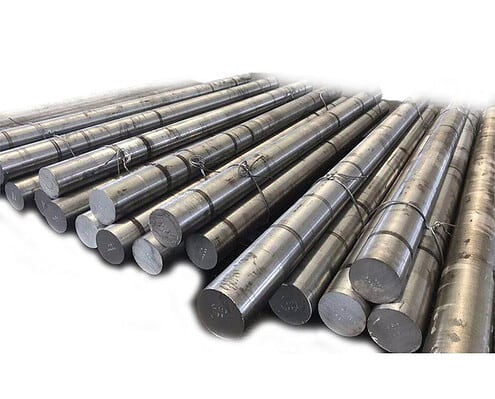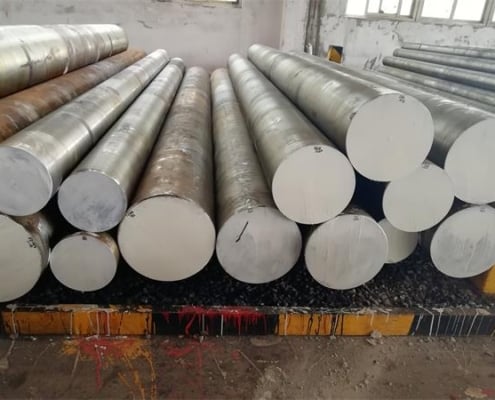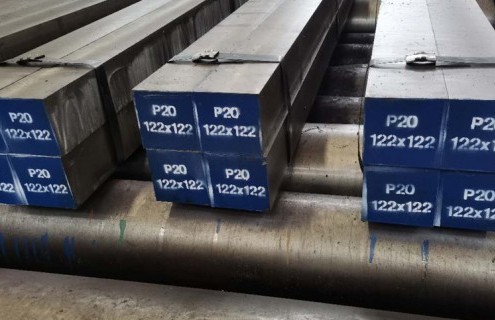H13 Steel | AISI H13 | 1.2344 | SKD61
WALDUN is one of the top H13 steel Manufacturer and Exporter China, can supplied with round,square,flat,block,and shaft etc. H13 steel is a chromium-molybdenum-vanadium hot work tool steel as per ASTM A681 standard.It has good resistance to abrasion at low and high temperature,good toughness, and good resistance to thermal fatigue cracking (also known as heat checking).H13 steel provides excellent machinability with constant hardness during production activities,and also has excellent through-hardening properties and very limited distortion during hardening.
The main characteristics of H13 steel are:
- High hardenability and high toughness.
- Excellent resistance to thermal cracking, which can be water-cooled in the workplace.
- Moderate resistance to wear, and a carburizing or nitriding process can be used to increase its surface hardness, but with a slight reduction in resistance to thermal cracking.
- Poor secondary hardening ability in tempering due to its low carbon content.
- resistance to softening at higher temperatures, but a rapid decline in hardness occurs at operating temperatures above 540°C (1000°F) (i.e., the working temperature that can be tolerated is 540°C).
- Low heat treatment deformation.
- Moderate and high machinability.
- Moderate resistance to decarburization.
- More notably, it can also be used to make important components in the aerospace industry.
H13 Steel Supply Form & Size & Tolerance
| Supply Form | Size(mm) | Process | Tolerance | |
| Round | Φ6-Φ100 | Cold Drawn | Bright/Black | Best H11 |
| Φ16-Φ350 | Hot Rolled | Black | -0/+1mm | |
| Peeled/ground | Best H11 | |||
| Φ90-Φ1000 | Hot Forged | Black | -0/+5mm | |
| Rough Turned | -0/+3mm | |||
| Flat/Square/Block | Thickness :120-800 | Hot Forged | Black | -0/+8mm |
| Width:120-1500 | Rough Machined | -0/+3mm | ||
Remark:Tolerance can be customized as per requests
H13 Steel Chemical Composition
| Standard | Grade | C | Si | Mn | P | S | Cr | Mo | V |
| ASTM A681 | H13 | 0.32-0.45 | 0.8-1.2 | 0.20-0.50 | 0.03 | 0.03 | 4.75-5.50 | 1.1-1.75 | 0.8-1.2 |
| DIN ISO 4957 | 1.2344 | 0.37-0.42 | 0.9-1.2 | 0.3-0.5 | 0.03 | 0.03 | 4.8-5.5 | 1.2-1.5 | 0.9-1.1 |
| GB/T 1299 | 4Cr5MoSiV1 | 0.32-0.42 | 0.8-1.2 | 0.2-0.5 | 0.03 | 0.03 | 4.75-5.5 | 1.1-1.75 | 0.8-1.2 |
| JIS G4404 | SKD61 | 0.35-0.42 | 0.8-1.2 | 0.25-0.5 | 0.03 | 0.03 | 4.8-5.5 | 1-1.5 | 0.8-1.15 |
H13 Steel Physical Property
| Temperature | 20°C | 400°C | 1110°C |
| Density,g/cm3 | 7.8 | 7.7 | 7.6 |
| Modulus of elasticity,N/mm2 | 210000 | 180000 | 140000 |
| Coefficient of thermal expansion,per °C from 20°C | — | 12.6 x 10^–6 | 13.2 x 10^–6 |
| Thermal conductivity,W/m °C | 25 | 29 | 30 |
| Melting point | 1427°C | ||
| Specific Gravity | 7.75 | ||
| Machinability | 65-70% of a 1% carbon steel | ||
H13 Steel Mechanical Property
| Tempering Tem. ℃ | After quenched | 200 | 400 | 500 | 520 | 550 | 580 | 600 | 650 | 700 |
| Hardness HRC | 56 | 54 | 54 | 55.5 | 54 | 52.5 | 49 | 45.5 | 33 | 28 |
| Tensile Strength Mpa | — | — | 2040 | 2100 | 2080 | 1980 | 1780 | 1650 | 1180 | — |
| Reduction of area | — | — | 40 | 34 | 40 | 48 | 53 | 54 | 55 | — |
| Elongation % | — | — | 11 | 11 | 11.5 | 12 | 12.5 | 14 | 18 | — |
| Impact J | — | — | 40 | 32 | 35 | 50 | 60 | 70 | 100 | — |
H13 Steel Forging
Heat AISI H13 with two steps,first heat the temperature to 750 oC – 800 oC ,hold for suitable time,then heat the temperature up to 1050 oC – 1100 oC,hold enough time for the steel to be thoroughly heated.Reheat is necessary when temperature below 950oC.H13 steel should be cooled as slowly as possible in the furnace.Annealing is always required after forged.
H13 Steel Annealing
Annealing is considered as a treatment suitable for machining.Heat the temperature to 840℃-860℃,hold suitable time for the steel to be thoroughly heated, then furnace cooling.Annealed black surface, hardness≤255HB.
H13 Steel Stress Relieving
It is recommended to stress relieve after machining and prior to hardening to minimise the possibility of distortion.H13 should be heated through to 600-650°C, holding time 2 hours. Cool slowly in furnace.
H13 Steel Hardening
Pre-heating temperature: 600–850°C,normally in two pre-heating steps.
Austenitizing temperature: 1020–1050°C,normally 1020–1030°C
| Temperature,°C | Soaking Time,Minutes | Hardness before tempering |
| 1025 | 30 | 53±2 HRC |
| 1050 | 15 | 54±2 HRC |
Soaking time = time at hardening temperature after the tool is fully heated through.
H13 Steel Tempering
Tempering should be carried out immediately after quenching. Heat slowly and uniformly to the tempering temperature,soak well not less than 2 hours(one hour per 25mm of total thickness).The usual tempering range is 530-650°C depending on the hardness requirements and the operating temperature of the tool.Double tempering is strongly recommended,H13 H13 should be cooled to room temperature between tempers.Tempering within the range 425-550°C is not recommended due to the reduction in toughness properties.
| Temperature ,°C | 400 | 500 | 550 | 600 | 650 |
| Hardness,HRC | 54 | 56 | 54 | 49 | 47 |
H13 Steel Application
H13 hot work tool steel has excellent properties which is widely used in hot work and cold work applications.
Typical applications include die casting dies for aluminium, magnesium and zinc, extrusion dies for aluminium and brass, liners, mandrels, pressure pads, followers, bolsters, die cases, die holders and adaptor rings for copper and brass extrusion. H13 is used to produce hot stamping and press forge dies, split hot heading dies, gripper dies, hot punching, piercing and trimming tools. Other applications include plastic moulds, shear blades for hot work and hot swaging dies.
FAQ About H13 Steel
What is H13 steel?
H13 steel is a type of high tensile strength low alloy structural steel. H13 steels are designed to be an economical, lower-strength alternative to H11 and H22 grades in most applications. The ASTM International specification for H13 grade is A572/A572M-10. H13 steel has a minimum yield strength of 55,000 psi and no requirement for zinc coating. H13 steels are typically produced in hot-rolled or cold-finished conditions depending on the application requirements. H11 is an upgrade from H14 grades with improved mechanical properties at higher strengths but similar weldability to H14 grades.
What are some common uses for H13 Steel?
H13 steel can be used where high strength levels are required after moderate forming operations have been completed while avoiding significant additional costs which would result if more expensive alloying elements were added. This means that it’s very useful in automotive applications, gears, couplings/coupling shafts along with other components involved within automobiles across numerous industries including aerospace & defense, heavy engineering and agricultural equipment. H13 steel is also used in the manufacture of railway track components such as switches, crossings and points.
What are the benefits of H13 Steel?
H13 steels offer good toughness combined with excellent weldability and formability making it a popular choice for many fabricators. It can be easily machined to close tolerances and has good resistance to wear, tear and fatigue making it an ideal material for use in high-stress environments. The combination of strength and toughness make H13 steel suitable for both static applications (where loads do not change) and dynamic applications (where loads fluctuate).
Are there any drawbacks to using H13 Steel?
One potential drawback may be its susceptibility to hydrogen embrittlement. H13 steel is susceptible to cracking in the heat affected zone due to the alloy’s low chromium content and therefore, may have difficulties with some welding processes including submerged arc welding (SAW) or gas metal arc welding(GMAW). H13 steels are also only available up to a maximum thickness of 12mm since its strength becomes a limiting factor beyond this point. Another potential drawback could be that H13 steel grades do not include percentage carbon ranges which would enable end users/welders to determine if their applications require H11 or H22 grade alloys instead of H13.
Is H13 corrosion resistant?
H13 is not corrosion resistant and therefore, may require a coating if used in an environment where it will be exposed to corrosive elements.
What are the H13 equivalent grades?
The closest H13 equivalent grade would be H11 or H22 alloys which have similar chemical compositions but offer better mechanical properties. If higher strength levels are required, then H14 or H19 grades should be considered.
What is the difference between H13 and other steel grades?
The main difference between H13 and other steel grades is its lower chromium content which makes it more susceptible to cracking when welding. It also has excellent toughness and weldability making it a popular choice for many fabricators. Other steel grades such as H11, H14 and H19 offer higher strength levels but may not be as tough or weldable.
What is the yield strength of H13 Steel?
The minimum yield strength for H13 steel is 55,000 psi.
Is H13 grade available in stainless steel?
No, H13 grade is only available in carbon steel alloys. If a stainless steel alloy is required, then 304 or 316 grades should be considered.
Where can I get more information on H13 Steel?
For more information on ASTM International standards H13 steel grades, H11 grade or H22 grade steels you can visit the ASTM International website. For more information on H13 steel properties, its heat treatment and characteristics of H13 steels in general please contact us directly.
Page Contents
- H13 Steel Supply Form & Size & Tolerance
- H13 Steel Chemical Composition
- H13 Steel Physical Property
- H13 Steel Mechanical Property
- H13 Steel Forging
- H13 Steel Annealing
- H13 Steel Stress Relieving
- H13 Steel Hardening
- H13 Steel Tempering
- H13 Steel Application
- FAQ About H13 Steel
- What is H13 steel?
- What are some common uses for H13 Steel?
- What are the benefits of H13 Steel?
- Are there any drawbacks to using H13 Steel?
- Is H13 corrosion resistant?
- What are the H13 equivalent grades?
- What is the difference between H13 and other steel grades?
- What is the yield strength of H13 Steel?
- Is H13 grade available in stainless steel?
- Where can I get more information on H13 Steel?













